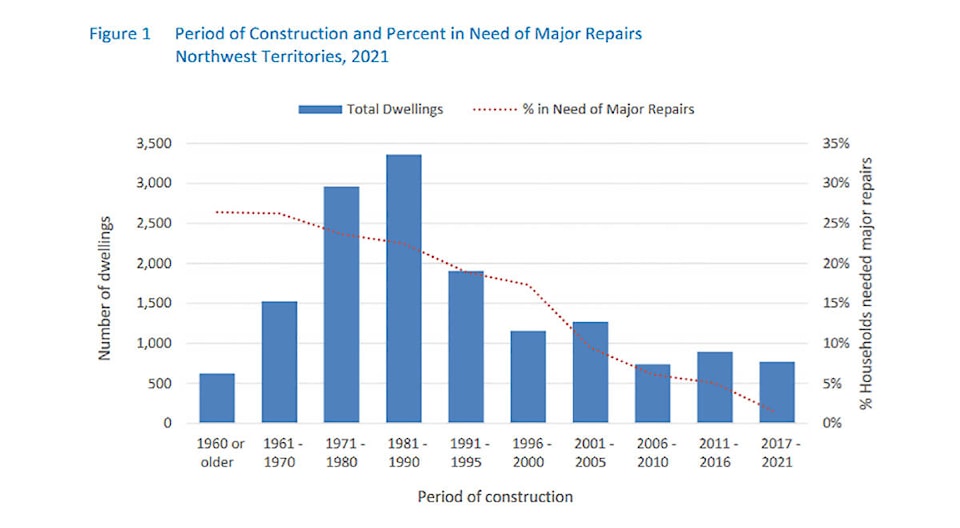Over half of all dwellings in the Northwest Territories are more than 30 years old and nearly a quarter of those homes are in desperate need of major repairs.
The NWT Bureau of Statistics released figures on Sept. 21 compiled from the 2021 census. The numbers show that just over 2,800 homes are in need of major repairs, 5,180 require minor repairs and 7,225 are behind on required maintenance.
Many of these housing issues are compounded by the fact the homeowners don’t have the funds needed to make the repairs.
A majority of these problem houses are in rural communities — Fort McPherson being in the worst shape, per capita, with 43 per cent of the homes in need of some sort of repair. Aklavik isn’t far behind, with just under 40 per cent of its homes in need of work.
Fort Liard and Tuktoyaktuk have between 30 and 35 per cent problem dwellings while Ulukhaktok, Tulita, Déline, Fort Good Hope and Fort Resolution all sit between 20 and 30 per cent of homes in disrepair.
Lutsel Kʼe, Fort Providence, Whatì, Fort Simpson, Behchoko and Paulatuk have between 15 and 20 per cent of homes requiring work.
Yellowknife, Fort Smith and Gamètì have between 10 and 15 per cent problem housing,
Norman Wells and Inuvik are roughly at seven per cent while Hay River has the least troubled housing in the territory at five per cent.
Overall, 13.2 per cent of the homes in the NWT need repairs and the homeowners don’t have the funds to do them, which is the third worst outcome in the country. British Columbia is slightly worse off at 13.4 per cent while Nunavut is at an extraordinary 32.9 per cent.
The bureau’s report notes while major repairs hamper smaller communities in the NWT, in larger population centres the problem most identified is affordability, where 12 per cent of households spend more than 30 per cent of their income on home expenses such as rent, mortgage or utilities. That was a slight improvement from the previous census in 2016, which the report attributes to Covid-19 benefit programs offsetting the cost of living.
A third problem facing people across the NWT is the suitability of a space — whether it has enough bedrooms, bathrooms or living space for the needs of the occupants. The bureau states that just under 1,600 households in the territory reported not having sufficient living space, with about 16 per cent of renters living in cramped quarters, compared to eight per cent of homeowners.
Homeownership has increased slightly in the NWT since 2016, but the costs of maintaining those homes has increased significantly. Data show that 90 more people in the NWT owned their homes as of 2021, up to 8,135 from 8,045 in 2016. The number of people renting homes also increased — from 6,915 in 2016 to 7,020 in 2021.
The average monthly cost for an NWT homeowner in 2021 was $1,740 — an increase of $159 from 2016.
The average monthly cost for a renter in 2021 was $1,450, an increase of $152. The bureau’s report cautions that the cost of maintaining a dwelling for renters is lower largely because of housing subsidies.
The analysis closes with a note that “There appears to be an issue in the distribution between subsidized and non-subsidized rented households in the 2021 census data for the Northwest Territories. The NWT Bureau of Statistics is contacting Statistics Canada to investigate further.”
